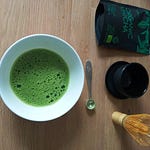I’m excited to announce a new offering for Bishop Chronicles paid subscribers: exclusive guided meditations designed to help you embody the four cardinal Stoic virtues—wisdom, courage, justice, and temperance. Get comfortable, put on some headphones and enjoy my new series of guided meditations for overcoming negative self talk, and embracing the stoic virtues more deeply. Click above to begin! These aren’t abstract philosophical concepts meant to be admired from a distance. These are practices designed to rewire the negative self-talk that has kept you small, to help you connect more deeply with yourself and the person you aspire to become. As the Buddha taught, “More than those who hate you, more than all your enemies, an undisciplined mind does greater harm.” For too many years, I let an undisciplined mind do exactly that kind of harm. Teachers, so-called friends, and others told me I wasn’t smart, wasn’t strong, wasn’t attractive—and over time, those comments became the toxic highlight reel that played in my mind, telling me everything I was not and everything I was unworthy of. By 2018, in the middle of my divorce, I realized I had become my own worst enemy. I didn’t need haters. I was doing their job for them.
Photos of rare items from Greece and Rome at The British Museum, London UK. Photo by Adisa Banjoko, copyright 2024.
Everything changed during the pandemic in 2020 when I was staying in London. My friend Professor Leo Jones Jr. reached out to tell me about a speaker named Paul Solomon, who had developed a simple but transformative mantra: “I will. I can. I do. I am.” My partner was much more deeply entrenched in guided meditations. She had been sharing beautiful guided meditations with me, but this—this was different. I grabbed a small pile of post-it notes and my favorite pen, my hand trembling slightly as I wrote the words. Then came the hard part. I stared at that yellow square of paper, feeling a knot of fear tightening in my chest. At the time, we were both brown belts in Brazilian Jiu-Jitsu, and I had given up on ever achieving the rank of Professor (the proper title for a BJJ black belt). When Leo texted me photos of himself writing out the mantra in full sentences—”I will get stronger this year. I can find new ways to grow financially. I do love myself. I am powerful”—something clicked. As a lifelong writer, I knew instantly I needed to do the same. I made myself a cup of matcha tea, sat down with that stack of post-it notes, and wrote: “I will be a black belt. I can be a black belt. I can do what black belts do. I am a black belt.” My stomach churned. As a brown belt, writing those words felt like supreme blasphemy, like I was lying to myself and to the art I loved. But I stood up, walked to the mirror, and with a reluctant hand that felt almost rebellious, pressed that post-it onto the glass. I looked at it. I looked at myself. And I began to say it aloud.
The real magic happened when I took those words into the world. London mornings were dark and cold during lockdown—the kind of darkness that swallows you whole at 5 AM. I’d step out of our flat into streets still slick with rain, the glow of red double-decker buses cutting through the fog as they rumbled past nearly empty roads. Commuters with masked faces hurried toward the Tube. Shop fronts were shuttered. The city felt suspended, holding its breath. And there I was, walking to secret training sessions, whispering my mantra into the cold air: “I will be a black belt. I can be a black belt. I can do what black belts do. I am a black belt.” Each word became a footstep. Each repetition changed something in my posture, in the way I held my shoulders. I moved differently—with more presence, more confidence. A local black belt allowed me to train in his space, and those sessions became sacred. When we drove up North, to Leeds (one of my most favorite cities on earth), the practice intensified. I’d jog through the icy winter mornings, snow crunching under my feet, my breath visible in the frozen air, and those four lines carried me forward. I found another crew of BJJ renegades willing to share space to practice during the lockdown. I studied online videos, documented my experiences through Stoic journaling, and called my instructor back in San Jose, Alan “Gumby” Marques, at Heroes Martial Arts pouring over techniques and insights. He would give me feedback on my experiences and encouraged me to train as much as I could.
A hypnotizing collection of books at The British Museum in London, UK. Photo by Adisa Banjoko, copyright 2024.
Then something else shifted. As I read more deeply into Seneca’s letters, as I absorbed Marcus Aurelius’s Meditations, as I took online classes on Stoic practices, it occurred to me: I could make my mantras Stoic. I could fuse Paul Solomon’s method with the ancient wisdom of the virtues. “I will seek wisdom. I can practice moderation. I do just actions. I am courageous.” The words felt like they’d been waiting for me all along. On July 21, 2021, Gumby awarded me my black belt. I never stopped using what I now call the Paul Solomon Method, and I’ve remixed it with the Stoic virtues to create something even more powerful.
Essentially, I have created Stoic Yoga Nidra for you to enhance your ability to understand and experience the benefits of the stoic virtues in real time.
Yoga nidra, also known as “yogic sleep,” is an ancient relaxation technique that combines guided mental imagery with a specific yoga posture called Shavasana (corpse pose). Unlike traditional yoga with its physical postures and movements, yoga nidra is practiced lying down in a state of conscious relaxation. The goal is to achieve a profound state of rest that differs from sleep—you remain aware of your surroundings while your body and mind enter deep relaxation.
During yoga nidra, practitioners are guided through a systematic process that typically includes:
Body scanning and awareness of different body parts
Breath awareness
Visualization exercises
Setting an intention or resolve (called sankalpa)
Progressive relaxation of the nervous system
The practice guides you into a state between waking and sleeping, where the brain transitions from beta waves (normal waking consciousness) to alpha waves (relaxation) and sometimes theta waves (deep meditation). This borderline state allows access to the subconscious mind, making yoga nidra particularly effective for rewiring negative thought patterns and habits.
Scientifically Proven Benefits
Research on yoga nidra has expanded significantly since the 1960s, with neuroimaging studies and clinical trials demonstrating measurable physical and psychological effects:
Mental Health & Stress Reduction
Reduces anxiety and depression: Multiple studies have shown that yoga nidra significantly reduces psychometrically measured indices of mild to moderate depression and anxiety
Lowers stress levels: Effective in reducing stress across various populations, including college professors, nursing students, and cancer patients
Post-traumatic stress disorder (PTSD) relief: Has been used successfully as an intervention for trauma-related conditions
Improves emotional regulation: Helps practitioners develop better control over emotional responses
Sleep & Cognitive Function
Enhances sleep quality: A 2023 study published in PLOS ONE found that just two weeks of yoga nidra practice improved slow-wave sleep (deep sleep) quality and duration
Boosts memory and learning: The enhanced deep sleep contributes to improvements in attention, learning, memory, and other cognitive tasks
Increases mental clarity: Practitioners show faster response times in cognitive tests with no loss in accuracy
Improves focus and concentration: Regular practice enhances attention span and mental sharpness
Neurological Changes
Increases dopamine release: Neuroimaging studies have shown that yoga nidra produces changes in endogenous dopamine release in the brain’s striatum, associated with reward, motivation, and reduced anxiety
Alters cerebral blood flow: Brain imaging confirms measurable changes in blood flow patterns during practice
Activates specific brain regions: Studies show activation of the primary sensory cortex while dampening regions involved in executive control, emotion processing, and motor planning—consistent with deep relaxation
Physical Health Benefits
Reduces blood pressure: Significant reductions in both systolic and diastolic blood pressure, particularly beneficial for hypertension patients
Improves cardiovascular health: Positive effects on heart rate and other cardiovascular parameters
Regulates hormones: Studies show hormonal rebalancing, including reductions in thyroid-stimulating hormone, prolactin, and improvements in menstrual irregularities
Lowers blood glucose levels: Beneficial effects for diabetes management, with improvements seen after one month of practice
Reduces chronic pain: Effective in pain management for various conditions
Well-being & Personal Growth
Increases self-esteem and self-confidence: Practitioners report improved self-image and greater self-assurance
Enhances mindfulness: Develops greater present-moment awareness
Promotes positive attitude: Shifts perspective toward more optimistic thinking patterns
Improves overall well-being: Comprehensive improvements in quality of life measures
Accessibility & Effectiveness
One of yoga nidra’s greatest advantages is its accessibility. Studies have shown that even short sessions—as brief as 11 minutes daily—can produce measurable benefits in stress reduction, sleep quality, and well-being. The practice requires no special equipment, no physical fitness, and no prior meditation experience. Because it’s practiced lying down, it’s accessible to people with physical limitations who might struggle with other forms of yoga or meditation.
Research indicates that benefits can appear quickly (within 2-4 weeks of regular practice) and remain stable over time, making yoga nidra a practical, low-cost intervention for mental and physical health that can be integrated into even the busiest schedules.
The Bottom Line
The scientific evidence supporting yoga nidra is substantial and growing. From measurable neurological changes like increased dopamine release to improvements in sleep, mental health, cardiovascular function, and cognitive performance, yoga nidra represents a validated, evidence-based practice for enhancing overall well-being. Its combination of accessibility, effectiveness, and minimal time investment makes it a powerful tool for anyone seeking to reduce stress, improve sleep, and cultivate a deeper connection with themselves.These guided meditations will help you visualize and internalize wisdom, courage, justice, and temperance in your daily life. The first meditation uses the foundational “I will. I can. I do. I am.” mantra to eradicate negative self-talk, followed by Stoic virtue affirmations that root these aspirations in practical philosophy. My hope is that this method transforms your relationship with yourself the way it transformed mine—not through empty positive thinking, but through disciplined practice that builds new neural pathways and genuine self-belief. This is just the beginning. Expect many new variations as we explore different dimensions of Stoic practice together, along with exclusive interviews and audio conversations with top-tier scholars and artists from various backgrounds—thinkers and creators who will be lending their wisdom on content I’m curating specifically for you. Only THIS episode of my stoic yoga nidra guided meditations will be free. Going forward, every Thursday exclusive content will drop.
I want to take a moment to thank you, my subscribers, for supporting Bishop Chronicles. These are hard times for everyone and I know you could spend your money on anything else. That you chose to spend it with me, means more than you can ever know. Your support makes this work possible and allows me to dig deeper, to create more, to bring you resources that matter. I encourage you not only to use these meditations for your own benefit, but to share Bishop Chronicles with friends who might need this work in their lives. Together, we’re building a community committed to living with intention, virtue, and presence. This is what my Resilient Mens Group is about (we meet online on Sundays from 11am-1pm PST 7-9 pm UK time). DM me on IG @bishopchronicles to join. Welcome to the work of becoming who you truly are. Please give me any feedback you like. I will take any and all feedback into consideration to make this podcast better.












